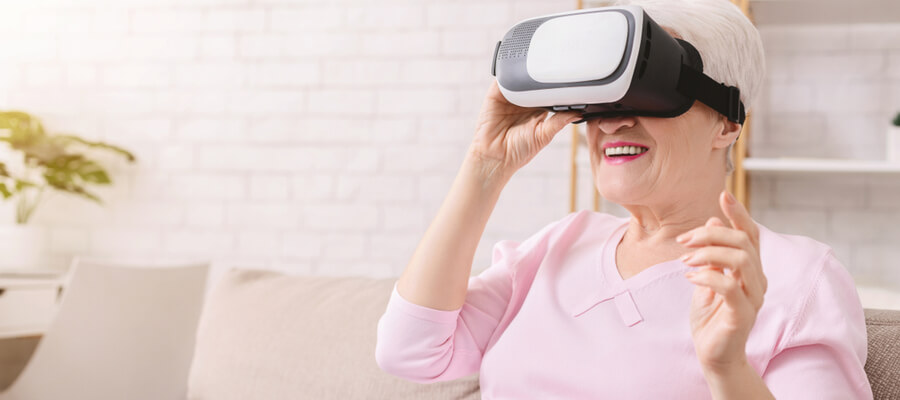By Joyce Wayne
When I hear the words “virtual reality,” I think about young, obsessed video gamers glued to the screen in their parents’ windowless basements. What I don’t think about is the new possibilities VR offers retirees: “real” simulated experiences. That could be hiking trips to the Rockies, boating off the coast of Costa Rica, or hot air ballooning in Arizona. The choices are virtually endless. For those of us unable to travel or confined to close quarters during Covid, VR could pose an exciting and practical alternative to being there.
Beyond enjoyment and entertainment, VR could offer “immersive experiences going deeper and helping tackle isolation and cognitive decline, two of the biggest issues as we age,” according to the online magazine Next Avenue. Many studies show how isolation is linked to a 50 percent higher risk of dementia. “With this in mind VR could power new social connections via shared experiences,” says Kyle Rand, the CEO of Rendever, a Massachusetts high-tech company focusing on health solutions for older adults.
Rather than travelling solo with only a headset and screen for company, we could be strolling along New York’s Fifth Avenue while chatting with friends. We’ll be able to schedule group sessions with friends or newcomers with similar interests we meet online. Connections and conversations make the VR experience much more than a slide show could ever be.
What Research Says About Virtual Reality?
MIT research shows that assisted-living residents who tried VR activities exhibited fewer indicators of depression and social isolation and enjoyed better moods than those who watched television. VR could operate the same way for older adults who live alone. In the U.S., one in four adults live alone, and the numbers are rising in Canada.
According to Next Avenue, “Some VR companies are piloting programs in which an elder and a family member in different places each get a headset and go virtual adventuring together, distance be damned. This may reinvent the family reunion, with clans gathering on tech-created virtual mountaintops and beaches – wherever our imaginations lead.”
Similarly, more research shows that digital reminiscence therapy (uploading and sharing materials that trigger personal memories) can improve the mood of those with cognitive impairments. “VR can clearly have positive benefits for patients with dementia, their families and caregivers. It provides a richer and more satisfying quality of life than is otherwise available,” said Jim Ang, this 2020 U.K. study’s researcher.
The same week as Next Avenue published this jubilant article about Virtual Reality, the New Yorker provided its reader with a selection of pieces that decry the new reliance on the virtual life. Canadian Adam Gopnik added his two cents in “The New Theatrics of Remote Therapy,” his New Yorker article about virtual therapy. The ironic and often darkly humorous Gopnick describes how different online therapy is from face-to-face meetings with a therapist. Therapists find that the screen changes the texture of intimacy. “Most treatment, after all, involves the careful budgeting of eye contact,” New York psychologist and psychoanalyst Barbra Zuck Locker explains, which plays out differently during an online session. “Patients look away, they look down, and finally focus, at a moment of intensity—a climax.” Her colleague Leonard Groopman, a psychiatrist, puts it bluntly: “You’re full frontal now for forty-five minutes. It adds hysteria to an already hysterical situation.”
I haven’t seen my family doctor in almost two years since my last annual check-up. Instead, we talk on the phone. At first, I preferred talking to Dr. A by telephone. An appointment is made with the front desk, and he calls me right on time, the same day or the next. To make a proper diagnosis, Dr. A asks all the appropriate questions, and I answer as best I can. It’s a short conversation with the physician I’ve known and trusted for more than 25 years. Yet, 18 months into the pandemic, I confess, I’d like to visit him in person, not for any specific medical reason, just because the virtual interaction leaves something human out of the doctor-patient equation.
How we chose to conduct our lives during this ongoing pandemic and afterward is up for grabs. Historian and friend Alvin Finkel writes in Plagues and Social Change: Putting Covid-19 in Historical Context in the past, often improved conditions for the “lower orders.” He suggests, “After the Black Death of 1347-52, which cut the population of Europe in half and accounted for some 75 million deaths globally, the feudal system faced challenges from peasant uprisings while labour shortages resulted in large wage increases for day workers. Orphanages and hospitals, run by churches and wealthy laypeople, sprang up in towns across the continent. While social changes in the aftermath of plagues build on transformations that were already occurring in societies, they often rapidly accelerate such changes.”
Working from home, VR, more conscientious long-term care coupled with a growing consideration for older adults is what’s needed to help us age comfortably while not removing us from the mainstream of society. In the meantime, we’re approaching the fall and winter with ample time to experiment with new forms of contact and communication, depending on how the virus mutates and what decisions governments implement to protect our safety.
 |







